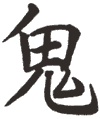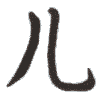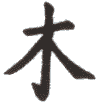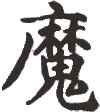
devil
|
|
When
the Chinese, very early in their history as a separate people, found a need to communicate
with a written language, a system of word-pictures was invented in keeping with the
characteristic calligraphy of the ancient world. True to all primitive written languages,
these so-called pictographs were satisfactory for representing objects buy carried
limitations in expressing abstract concepts. The early graphic symbols, therefore, were
combined in meaningful ways to convey ideas, called ideograms, and these "picture
stories" of necessity had to contain common knowledge in order to be understood. It
would have been only natural to use as a basis for some of the ideograms the history of
the ancient beginnings of humanity with which all were familiar by oral tradition.
Consequently, the written Chinese language is composed of characters uniquely adapted to
the possibility of containing the stories of Genesis.
|
|

cover
|

man, son

garden, field
|
|
We
might illustrate at this point just what an ideogram is and how a concept such as the word
"tempter," for example, could be translated into an expressive written character
by graphically depicting the story of Eve's encounter with the devil in the Garden of
Eden. In this first historic moment of temptation the devil must of course be pictured.
Three primitive pictographs were selected to accomplish this: a garden, field or
landed property  represents
the Garden of Eden; a man, son represents
the Garden of Eden; a man, son  shows the humanoid aspect of the devil, who spoke as a man to Eve, even though through the
medium of a serpent; and the word secret, private
shows the humanoid aspect of the devil, who spoke as a man to Eve, even though through the
medium of a serpent; and the word secret, private  conveys his clandestine approach to Eve. These three
symbols, together with the "p'ieh" conveys his clandestine approach to Eve. These three
symbols, together with the "p'ieh"  indicating "alive," are combined in the
devil indicating "alive," are combined in the
devil  . .
|
|

tree |

secret, private |
|
But to
be more specific, the devil  radical is then placed under the cover radical is then placed under the cover
 of protecting trees of protecting trees  . The devil . The devil
 waited for Eve in the forbidden tree, which was located in the
middle of the garden next to the tree of life--hence the two trees waited for Eve in the forbidden tree, which was located in the
middle of the garden next to the tree of life--hence the two trees  . Furthermore, he was under cover . Furthermore, he was under cover  ,
being hidden in the tree and also camouflaged as a serpent. By uniting these primitive
pictographs into an ideographic character, the word tempter ,
being hidden in the tree and also camouflaged as a serpent. By uniting these primitive
pictographs into an ideographic character, the word tempter  appears to have been designed. Or
were these six significant constituent symbols brought together by mere chance? appears to have been designed. Or
were these six significant constituent symbols brought together by mere chance? |
|

tempter |
|
|
|
|
|
|
 |
[The
above text is presented here with no permission]
|